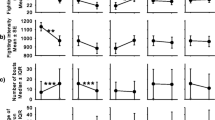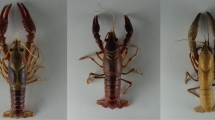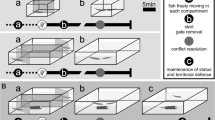Abstract
There is plenty of evidence that resource value is one of the most important non-strategic variables in animal fighting behavior. Here, we tested whether the past ownership of a shelter might modify the agonistic behavior of the crayfish Austropotamobius pallipes, eventually increasing its probability to win when it reencounters a previously met conspecific away from that resource. The agonistic behavior of familiar pairs composed of size-matched males was observed for an hour; after that, the two contestants had been kept in isolation for 2 days, either in the presence or in the absence of a shelter. Specifically, in the isolation phase, a shelter was offered to (1) both crayfish, (2) no crayfish, (3) the dominant crayfish only, and (4) the subordinate crayfish only. The following combat was conducted in the absence of any refuge. The crayfish that previously owned a shelter showed a higher aggressive motivation to fight than the individuals kept without a shelter. Particularly, in the pairs (4), subordinate crayfish were even more aggressive than dominants but were never able to invert hierarchies. Taken together, our results confirm the role played by shelters as determinants of agonism and also show, for the first time, how the behavior of crayfish and their internal state may be affected by their past ownership of a resource.


Similar content being viewed by others
References
Austad SN (1983) A game theoretical interpretation of male combat in the bowl and doily spider (Frontinella pyramitela). Anim Behav 31:59–73
Barbaresi S, Gherardi F (2006) Experimental evidence for homing in the red swamp crayfish, Procambarus clarkii. Bull Fr Pêche Piscic 380–81:1145–1153
Beaugrand JP, Zayan R (1985) An experimental-model of aggressive dominance in Xiphophorus helleri (Pisces, Poeciliidae). Behav Process 10:1–52
Bentley T, Hull TT, Hardy ICW, Goubault M (2009) The elusive paradox: owner–intruder roles, strategies, and outcomes in parasitoid contests. Behav Ecol 20:296–304
Bergman DA, Moore PA (2003) Field observations of intraspecific agonistic behaviour of two crayfish species, Orconectes rusticus and Orconectes virilis, in different habitats. Biol Bull 205:26–35
Bernardo JM, Ilheu M, Costa AM (1997) Distribution, population structure and conservation of Austropotamobius pallipes in Portugal. Bull Fr Pêche Piscic 347:617–624
Bovbjerg RV (1953) Dominance order in the crayfish Orconectes virilis (Hagen). Physiol Zool 26:173–178
Bovbjerg RV (1956) Some factors affecting aggressive behavior in crayfish. Physiol Zool 29:127–136
Bovbjerg RV (1970) Ecological isolation and competitive exclusion in two crayfish (Orconectes virilis and Orconectes immunis). Ecology 51:225–236
Bridge AP, Elwood RE, Dick JTA (2000) Imperfect assessment and limited information preclude optimal strategies in male–male fights in the orb-weaving spider Metellina mengei. Proc R Soc B 267:273–279
Bruski C, Dunham DW (1987) The importance of vision in agonistic communication of the crayfish Orconectes rusticus. An analysis of bout dynamics. Behaviour 103:83–107
Cant MA, English S, Reeve HK, Field J (2006) Escalated conflict in a social hierarchy. Proc R Soc B 273:2977–2984
Capelli GM, Hamilton PA (1984) Effects of food and shelter on aggressive activity in the crayfish Orconectes rusticus (Girard). J Crustac Biol 4:252–260
Capelli GM, Magnuson JJ (1983) Morphoedaphic and biogeographic analysis of crayfish distribution in northern Wisconsin. J Crustac Biol 3:548–564
Carsten LD, Papaj DR (2005) Effects of reproductive state and host resource on mating decisions in a walnut fly. Behav Ecol 16:528–533
Chellappa S, Yamamoto ME, Cacho MSRF, Huntingford FA (1999) Prior residence, body size and the dynamics of territorial disputes between male freshwater angelfish. J Fish Biol 55:1163–1170
Copp N (1986) Dominance hierarchies in the crayfish Procambarus clarkii and the question of learned individual recognition. Crustaceana (Leiden) 51:9–24
DiDonato GT, Lodge DM (1993) Species replacements among Orconectes crayfishes in Wisconsin lakes: the role of predation by fish. Can J Fish Aquat Sci 50:1484–1488
Dunn DW, Crean CS, Gilburn AS (2002) The effects of exposure to seaweed on willingness to mate, oviposition, and longevity in seaweed flies. Ecol Entomol 27:544–564
Edsman L, Jonsson A (1996) The effect of size, antennal injury, ownership, and ownership duration on fighting success in male signal crayfish, Pacifastacus leniusculus (Dana). Nord J Freshw Res 72:80–87
Englund G (1999) Effects of fish on the local abundance of crayfish in stream pools. Oikos 87:48–56
Englund G, Krupa JJ (2000) Habitat use by crayfish in stream pools: influence of predators, depth and body size. Freshw Biol 43:75–83
Enquist M, Jakobsson S (1986) Decision making and assessment in the fighting behaviour of Nannacara anomala (Cichlidae, Pisces). Ethology 72:143–153
Enquist M, Leimar O (1987) Evolution of fighting behaviour: the effect of variation in resource value. J Theor Biol 127:187–205
Fayed SA, Jennions MD, Backwell PRY (2008) What factors contribute to an ownership advantage? Biol Lett 4:143–145
Fero K, Simon JS, Jourdie V, Moore PA (2007) Consequences of social dominance on crayfish resource use. Behaviour 144:61–82
Figler MH, Klein RM, Peeke HVS (1976) The establishment and reversibility of dominance relationships in jewel fish, Hemichromis bimaculatus Gill (Pisces, Cichlidae): effects of prior exposure and prior residence situations. Behaviour 58:254–271
Figler MH, Blank GS, Peeke HVS (2001) Maternal territoriality as an offspring defense strategy in red swamp crayfish (Procambarus clarkii, Girard). Aggress Behav 27:391–403
Figler MH, Blank GS, Peeke HVS (2005) Shelter competition between resident male red swamp crayfish Procambarus clarkii (Girard) and conspecific intruders varying by sex and reproductive status. Mar Freshw Behav Physiol 38:237–248
Fisher HS, Rosenthal GG (2006) Hungry females show stronger mating preferences. Behav Ecol 17:979–981
Garcìa-Arberas L, Ralo A (2000) Survival of natural populations of Austropotamobius pallipes in rivers in Bizcaia, Basque Country (North Iberian Peninsula). Bull Fr Pêche Piscic 356:17–30
Garvey JE, Stein RA, Thomas HM (1994) Assessing how fish predation and interspecific prey competition influence a crayfish assemblage. Ecology 75:532–547
Gherardi F (2006) Fighting behavior in hermit crabs: the combined effect of resource holding potential and resource value in Pagurus longicarpus. Behav Ecol Sociobiol 59:500–510
Gherardi F, Cioni A (2004) Agonism interference and competition in freshwater decapods. Behaviour 141:1297–1324
Gherardi F, Daniels WH (2003) Dominance hierarchies and status recognition in the crayfish Procambarus acutus acutus. Can J Zool 81:1269–1281
Gherardi F, Daniels WH (2004) Agonism and shelter competition between invasive and indigenous crayfish species. Can J Zool 82:1923–1932
Grandjean F, Bramard M, Souty-Grosset C (1996) Distribution and proposal for the conservation of the indigenous freshwater crayfish species, Austropotamobius pallipes pallipes, in a French department. Freshw Crayfish 11:655–664
Griffiths D (1992) Interference competition in ant–lion (Macroleon quinquemaculatus) larvae. Ecol Entomol 17:219–226
Guiasu RC, Dunham DW (1997) Agonistic contests in male form I Cambarus bartoni (Fabricius, 1789) (Decapoda, Cambaridae) crayfish and comparison with contests of the same type in Cambarus robustus Girard, 1852. Crustaceana 72:1079–1091
Hack MA (1997) Assessment strategies in the contests of male crickets, Acheta domesticus (L.). Anim Behav 53:733–747
Hack MA, Thompson DJ, Fernandes DM (1997) Fighting in males of the autumn spider, Metellina segmentata: effects of relative body size, prior residency and female value on contest outcome and duration. Ethology 103:488–498
Hazlett BD, Rubenstein D, Rittschof D (1975) Starvation, energy reserves, and aggression in the crayfish, Orconectes virilis (Hagen). Crustaceana 28:11–16
Hazlett BD, Acquistapace P, Gherardi F (2002) Differences in memory capabilities in invasive and native crayfish. J Crustac Biol 22:439–448
Hemsworth R, Villareal W, Patullo BW, MacMillan DL (2007) Crustacean social behavioral changes in response to isolation. Biol Bull 213:187–195
Herberholz J, Sen MM, Edwards DH (2003) Parallel changes in agonistic and nonagonistic behaviors during dominance hierarchy formation in crayfish. J Comp Physiol A 189:321–325
Hill AM, Lodge DM (1999) Replacement of resident crayfishes by an exotic crayfish: the roles of competition and predation. Ecol Appl 9:678–690
Hobbs HH Jr (1988) Crayfish distribution, adaptive radiation, and evolution. In: Holdich DM, Lowery RS (eds) Freshwater crayfish: biology, management, and exploitation. Timber Press, Portland, Oregon, pp 52–81
Holdich DM (2003) Ecology of the white-clawed crayfish. Conserving Natura 2000, Rivers Ecology Series no. 1. English Nature, Peterborough
Humphries EL, Hebblethwaite AJ, Batchelor TP, Hardy ICW (2006) The importance of valuing resources: host weight and contender age as determinants of parasitoid wasp contest outcomes. Anim Behav 72:891–898
Hunt J, Brooks R, Jennions MD (2005) Female mate choice as a condition-dependent life-history trait. Am Nat 166:79–92
Hyman J, Hughes M, Searcy WA, Nowicki S (2004) Individual variation in the strength of territory defense in male song sparrows: correlates of age, territory tenure, and neighbor aggressiveness. Behaviour 141:15–27
Keeley RE, Grant JWA (1993) Visual information, resource value, and sequential assessment in convict cichlid (Cichlasoma nigrofasciatum) contests. Behav Ecol 4:345–349
Lawton P (1987) Diel activity and foraging behavior of juvenile American lobsters Homarus americanus. Can J Fish Aquat Sci 44:1195–1205
Lindström K, Pampoulie C (2005) Effects of resource holding potential and resource value on tenure at nest sites in sand gobies. Behav Ecol 16:70–74
Lodge DM, Hill AM (1994) Factors governing species composition, population size, and productivity of coolwater crayfishes. Nord J Freshw Res 69:111–136
Lowe ME (1956) Dominance-subordinate relationships in the crawfish Cambarellus shufeldtii. Tulane Stud Zool 4:139–170
Martin AL, Moore PA (2008) The influence of dominance on shelter preference and eviction rates in the crayfish, Orconectes rusticus. Ethology 114:351–360
McNamara JM, Houston AI (1989) State dependent contests for food. J Theor Biol 137:457–479
Ohashi K, Thomson JD (2005) Efficient harvesting of renewing resource. Behav Ecol 16:592–605
Olsen TM, Lodge DM, Capelli GM, Houlihan RJ (1991) Mechanisms of impact of an introduced crayfish (Orconectes rusticus) on littoral congeners, snails, and macrophytes. Can J Fish Aquat Sci 48:1853–1861
Parker GA (1974) Assessment strategy and the evolution of animal conflicts. J Theor Biol 84:93–101
Peeke HVS, Sippel J, Figler MH (1995) Prior residence effects in shelter defense in adult signal crayfish (Pacifastacus leniusculus (Dana)): results in same- and mixed-sex dyads. Crustaceana 68:873–881
Pierce A, Ferkin M, Williams T (2005) Food deprivation induced changes in sexual behavior of meadow voles, Microtus pennsylvanicus. Anim Behav 70:339–348
Renai B, Bertocchi S, Brusconi S, Grandjean F, Lebboroni M, Parinet B, Souty Grosset C, Trouilhe MC, Gherardi F (2006) Ecological characterisation of streams in Tuscany (Italy) for the management of the threatened crayfish Austropotamobius pallipes complex. Bull Fr Pêche Piscic 380–381:1095–1114
Riechert SE (1984) Game spider play. III: Cues underlying context-associated changes in agonistic behaviour. Anim Behav 32:1–15
Riechert SE (1998) Game theory and animal contests. In: Dugatkin LA, Reeve HK (eds) Game theory and animal behaviour. Oxford University Press, Oxford, UK, pp 64–93
Smith IP, Huntingford FA, Atkinson RJA, Taylor AC (1994) Strategic decisions during agonistic behavior in the velvet swimming crab, Necora puber (L.). Anim Behav 47:885–894
Stocker AM, Huber R (2001) Fighting strategies in crayfish Orconectes rusticus (Decapoda, Cambaridae) differ with hunger state and the presence of food cues. Ethology 107:727–736
Tibbetts EA (2008) Resource value and the context dependence of receiver behaviour. Proc R Soc B 275:2201–2206
Tricarico E, Gherardi F (2007a) The past ownership of a resource affects the agonistic behavior of hermit crabs. Behav Ecol Sociobiol 61:1945–1953
Tricarico E, Gherardi F (2007b) Biogenic amines influence aggressiveness in crayfish but not their force or hierarchical rank. Anim Behav 74:1715–1724
Tricarico E, Renai B, Gherardi F (2005) Dominance hierarchies and status recognition in the threatened crayfish Austropotamobius italicus. Bull Fr Pêche Piscic 376–377:655–664
Tricarico E, Benvenuto C, Buccianti A, Gherardi F (2008) Morphological traits determine the winner of “symmetric” fights in hermit crabs. J Exp Mar Biol Ecol 354:150–159
Wilcox RS, Ruckdeschel T (1982) Food threshold territoriality in a water strider (Gerris remigis). Behav Ecol Sociobiol 11:85–90
Zulandt Schneider RA, Huber R, Moore PA (2001) Individual and status recognition in the crayfish, Orconectes rusticus: the effects of urine release on fight dynamics. Behaviour 138:137–153
Acknowledgments
We thank Silvia Bertocchi and Carmen Trunfio for their help in conducting the experiments, and Laura Aquiloni and Giuseppe Mazza for their help in collecting crayfish. We also thank Dr. Paul Moore and one anonymous reviewer for their helpful suggestions. No license was required for this work within Italy. All animals recovered from the experiments and were returned to the rivers. The authors declare that they have no conflict of interest.
Author information
Authors and Affiliations
Corresponding author
Additional information
Communicated by T. Moore
Rights and permissions
About this article
Cite this article
Tricarico, E., Gherardi, F. Past ownership makes crayfish more aggressive. Behav Ecol Sociobiol 64, 575–581 (2010). https://doi.org/10.1007/s00265-009-0873-8
Received:
Revised:
Accepted:
Published:
Issue Date:
DOI: https://doi.org/10.1007/s00265-009-0873-8




